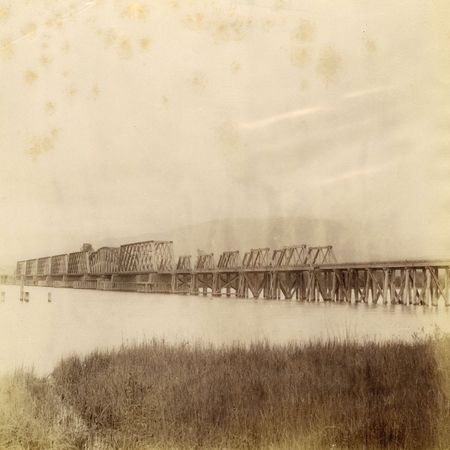
 604 465 4322
604 465 4322General Store Site 12294 Harris Road Pitt Meadows, B.C.
Click Here for Directions& Visiting Hours

Looking Back: Transforming the Crossing
Looking back Article from October 2019.
Transporting people and resources over the Pitt River is a historically evolving venture that shows our change in preference for modes of transportation alongside the rise in technology. From moving on the water to driving above it, the changes in how Pitt Meadows residents have traversed the river show our efforts to manipulate a natural obstacle to fit our growing appetite for travel and expansion.
Crossing the river began with the Indigenous people who used canoes. With the arrival of settlers, boats and ferries were used to move passengers, mail and freight. In 1885 the CPR builds a single-track steel railway bridge over the Pitt River. Ferries were used to getting near the railway bridge. A single passenger paid 50 cents to get there. In March 1915, the railway bridge was converted to accommodate vehicles. Doug McMyn, a Pitt Meadows resident, owned a truck-driving business that delivered milk to Vancouver for the farmers of Pitt Meadows and Maple Ridge. McMyn won a bet to be the first to cross the bridge. This bridge was so narrow that only two small cars could barely squeeze past each other. Despite the bridge, ferries were still used because the highway was not ideal for transportation after the rain.
In November 1957, a new two-lane bridge is built to replace the 1915 bridge. Doug McMyn was invited to be the first across in a horse and buggy. On October 24, 1978, a second two-lane bridge is opened adjacent to the bridge built in 1957. McMyn christened the 1978 bridge alongside his granddaughter Lorilee. The twin Pitt River bridges were not built high enough for ships and barges to pass underneath. A swing span was included, but sometimes the swing bridge would not close after opening because the hydraulic control was not synchronized with the computer. Although federal legislation restricted the swing span from opening during rush hour, it still caused traffic jams when it opened at other times. To meet the demands of an increasing population, a $13.5 million, two-kilometre-route counterflow system was introduced on October 9, 1997. This was the only bridge in Canada that had counterflow traffic. It saved motorists about 10 to 15 minutes, but it was only a short-term solution.
In 1985 27,000 cars crossed the bridge at its busiest times, by 2009 it was 90,000. On Oct. 25, 2009, Lorilee McMyn helped open the $198 million, seven-lane Pitt River Bridge which replaced the twin bridges and was expected to cut commute times by 30 per cent. The building of the new bridge is a part of the province’s Gateway program’s efforts to improve trade and tourism opportunities with Asia by helping move goods through the Lower Mainland and improve efficiency for the Port of Vancouver. It assisted with the movement of goods from Western Canada to U.S. markets. An improvement from prior bridges because it is twice as high, allowing for shipping to pass underneath, serves a growing population, meets the demands of international trade and thereby better connects Pitt Meadows to the world.
Rebekah Abebe, Museum Assistant at the Pitt Meadows Museum





